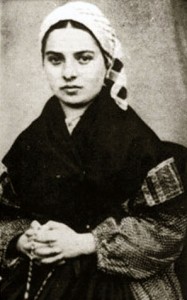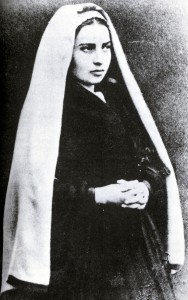I’ve always been captivated by Bernadette Soubirous, the visionary of Lourdes, and recently came across a book Bernadette Speaks (2000) by a French cleric who was involved in Vatican proceedings for her beatification. It’s dry as dust considering the inspirational power of her story, and annoying for the way he excuses the vicious treatment Bernadette received from the Mother Superior in the convent. Her words are chopped up by the interminable interrogations she was put through by clerics high and low.
But! it has two nuggets of interest. He says that Bernadette was “heiress” in her family. This custom is reminiscent of matrilineal Basque traditions, still a strong influence in this Bigorre country of the northern Pyrenean foothills. As late as the 6th century CE, this region was part of Aquitania, which still spoke a Basque-related language, not Gaulish or Roman. One of the tribes there, the Ausci, have a name quite close to the Basque name for themselves, Euskadi. Centuries later, the region was known as Gascogne or Gascony or Vasconia, a name directly related to Basque. But returning to the local family “heiress”:
This title was given the eldest daughter in any family of the matriarchal culture, still surviving in that part of France. The heiress held first place in the family and exerted an authority of the first order in family matters, even after the marriage of her brothers and sisters. [Laurentin, 13]
Bernadette was named after her aunt Bernarde, who was not only her godmother, but the previous heiress of her maternal line and a force in the Soubirous household. Her influence made itself felt after male authorities forbade Bernadette to return to the grotto of Massabielle during the period of her visions. The girl’s mother was afraid (understandably, they were some of the poorest people in a very class-conscious town). It was her aunt who said, “If I were in Bernadette’s place, I’d go.” And that was all Bernadette needed to take off for her beloved grotto. [66]
As church officials browbeat the visionary, accused her of lying, and demanded that sshe find out the name of the apparition, she agreed to ask. The answer she received was a phrase that Bernadette did not know or understand, even though the Lady spoke in her native patois: “Que soy era Immaculada Councepsiou.” I am the Immaculate Conception. Not I received or had it: I am that, the pure Origin.
This declaration cuts through layers of patriarchal Catholic theology to the Divine Mother as originator, in which fatherhood is not a consideration. The idea that Mary was conceived without sin had just surfaced in Catholic theology. I don’t believe that sex is sin, but this was a step toward elevating her to the level of deity in all but name, something long since been accomplished in the Marian devotion of the common people.
Bernadette knew nothing of theologians’ distinctions and parsings. She knew something much greater: what she saw and heard, an epiphany so intense that it immediately created excitement in her town, even though she was a pauper. She herself never claimed that she had seen the Virgin Mary. Bernadette simply called her Aquerò, That one, or era Demezella, the Lady. She stood up to the repeated questionings with spirit and aplomb, very much like that shown by Jeanne d’Arc centuries before.
Bernadette was bombarded by demands for the pettiest details about the Lady’s dress and appearance. While remaining polite, she repudiated the sculptures of the Lady commissioned for the chapel, wilting willowy figures of the usual type. “No, that’s not it.” In private she spoke of them more scornfully.
Bernadette flatly refused to reveal the secrets that had been entrusted to her alone, no matter what protestations of priestly authority were thrown at her. It wasn’t just the clergy that afflicted her. Wealthy people came and demanded to see her to question her. Women tried to cut off pieces of her hair, or her skirt. Her life was overturned by becoming, against all her inclinations, a celebrity.
The best-known account of her story is The Song of Bernadette. It was written by Franz Werfel, an Austrian Jew who was fleeing the Nazis a second time, and was given refuge in Lourdes. He heard her story from many people, and promised to write a book about it. Although fictionalized, it seems truer to the spirit of the people than the over-measured dogmatic descriptions of Laurentin. He captured the feeling that drew crowds to the grotto where Bernadette gazed, smiled, bowed, prayed her rosary; where she was transfigured with tears streaming down her face in ecstasies that electrified the assembled throngs of people:
Bernadette was … the perfect photographic negative of the invisible, which thereby was brought for the onlookers to the boundary of the visible. … all gazed breathlessly from the niche to the rock to the mediatrix and from the mediatrix from the niche. Their expectancy was satisfied. For the unexpected had become a presence. [102]
In her ecstasy, Bernadette was swept into a state of deep absorption, unconscious of what went on around her. Dr. Douzous, originally a skeptic, was deeply impressed by witnessing her communion while holding a large candle. Her hands slipped down over the flame and remained there for a quarter of an hour, the flame playing on them, and yet when he examined them afterward, there was no trace of burning, not even redness. “There’s nothing.” As Abbé Joanas recounted, “These words were passed rapidly back to the furthest part of the crowd and caused a wave of excitement approaching delirium.” [Life, 172]
Werzel imagines the interchange between her and the local curé after she told him the Lady’s name: “… if the Most Blessed Virgin were to speak, all she could say of herself would be: I am the fruit of the immaculate conception. She could not say: I am the immaculate conception. Birth and conception are an event. But a person is not an event. No one could say of himself: I am the birth of my mother. Eh?” [Werzel 1943: 209]
Yet something much like this is written in the Egyptian Gnostic scripture, Thunder, Perfect Mind: “I am the mother of my father.” And again: “I am the silence that is incomprehensible / and the idea whose remembrance is frequent. I am the voice whose sound is manifold / and the word whose appearance is multiple. / I am the utterance of my name.” [Nag Hammadi Texts]
The Raptures of Bernadette [I haven’t located the book that all quotes below are taken from, but will post when found]
On her second visit, Bernadette was again accompanied by a (larger) bunch of girls. One later remarked, “There were about twenty of us, all poor.” [50] Again the Soubirous girl went into rapture: “Her face was lit up.” She was smiling and unresponsive. Afraid she was on the verge of death, they ran to the mill for help. The miller’s wife got her son to go carry her away. He testified that he found on her on her knees, eyes wide open and gazing at the niche in the rock, with her hands together holding the rosary:
Tears were streaming from both her eyes. She was smiling and her face was lovely, lovelier than anything I’ve ever seen. It made me feel both happy and sad, and all day long my heart was moved at the thought of it. I remained for a time motionless, watching her. The girls were watching her like me; my mother and aunt were also spell-bound. [51]
Finally they roused themselves and tried to pull her away. “She struggled to stay. Her eyes remained fixed upwards. Not a murmur.” He lifted her and the whole group pulled and pushed her up the path. “She was trying hard to go down again, without however saying a word. It took a great effort to drag her along; strong as I am, it would have been heavy work, had I been alone.” Bernadette was still smiling with tears of joy running down her face, until they reached the mill and she came back to normal. [53]
From then on more and more people congregated to see the visionary encounter her Lady. Bernadette streaked ahead of the others and ran down to the river bank. Josèphe Baringue recounted,
As soon as the Apparition appeared, her smile became lovely and her countenance changed. She gave a greeting with her hand and head. It was a delight to see her. It was as if she had done nothing else all her life but learn how to bow. [63]
Her aunt Bernarde said, “To see her face like that brought tears to your eyes.” [63]
Again she was accompanied by a group of women. Madame Lannes said that she looked up, smiling: “then she became thoughtful and seemed to be listening with great devotion and reverence. I was very close to her, and several times I heard a long breath come through her lips; it was scarcely perceptible, as though she had uttered a very low and prolonged yes.” Her mother was amazed at the sight: “I can no longer recognize my child!” Even skeptics like Rosine Cazenave were deeply impressed. Romaine Mengelatte exclaimed, “If only you had seen her eyes! It was enough to bring you to your knees.” [66]
In a later encounter, when the crowds had grown, Jean-Baptiste joined them “to scoff and jeer.” What he witnessed changed his mind, as he later wrote:
Bernadette knelt down, pulled out her rosary from her pocket, and made a profound reverence. … While slipping the first few beads through her fingers, she raised her eyes to the rock in a searching gaze that betrayed her impatient longings. Suddenly, as though a flash of lightning had struck her, she gave a start of amazement, and seemed to be born into another life. Her eyes lighted up and sparkled; seraphic smiles played on her lips; an indefinable grace spread over her whole being.
Everyone sank to their knees, raptly gazing at the young visionary.
When the Lady was speaking, she thrilled with happiness; on the other hand when she herself was speaking and making her petitions, she would bow down to the ground and be moved to tears. …Usually the ecstatic ended her prayers with a profound reverence to the hidden Lady. I have moved much in society, perhaps too much, and I have encountered models of elegance and distinction; but never have I seen anyone make a bow with such grace and refinement as did Bernadette.
The same went for the slow. majestic movements with which she made the sign of the cross. After an hour, she kissed the ground. “Her face lit up with a last splendor; then gradually… but almost imperceptibly, the rapture faded and finally disappeared.” She continued praying a while longer, now looking like an ordinary peasant girl. [96-7]
On a later occasion, the crowd had reached over 400 people. The local paper Lavedan had deplored the goings-on at Massabielle but admitted, “Everything takes place quietly; we would even say, in a spirit of profound recollection. This child is for the multitude today the interpreter, if not perhaps the image, of a higher power.” The Lourdes Sergeant who had been stationed there reported to his superiors that before Bernadette had finished the first decade of her rosary, she “strained forward with a gentle movement of her whole body, as though she had caught sight of an object which enraptured her.” Without lowering her gaze, she began to bow and smile.
Someone accidentally disturbed the briar at the Lady’s feet, temporarily interrupting the vision. Moaning softly Bernadette moved around, searching within the grotto.
Bernadette’s face had clouded over, like the earth when the sun is hidden; then suddenly she recovered her radiance, and was heard to utter a faint ‘Ah’ as though she were saying, ‘Ah, what joy! There she is!’ While watching all this, I was saying to myself: ‘This little one is not inventing this.’ After a while, Bernadette stood up and turned toward the crowd. In a gasping voice she repeated, ‘Penance… penance… penance!’ [103]
On her next encounter, “The Lady said to me: ‘Go and drink at the spring and wash yourself in it.” Bernadette started for the
river, but was pointed back to the grotto where there was a wet patch. She dug into the ground, and water came, but still muddy. On her fourth try she was able to get enough to drink. When she turned around, there was consternation at the sight of mud on her face. People began crying that she was mad. Oblivious to everything but her vision, Bernadette crawled on her knees to another spot and, pulling from a clump of saxifrage, put it into her mouth and chewed it. The people were jeering. She made her “magnificent sign of the cross,” and fled with her family and supporters. [107]
After that, over the next days, the water began to flow, and people began to gather it to give to sick and diseased people. In spite of the negative reaction, Bernadette’s next visit was nevertheless attended by most of the town’s population. This was perhaps her longest ecstasy. Abbe Pène observed that Lourdes seem emptied of its inhabitants and unnaturally quiet. 140 The clergy were in an uproar and held meetings with town officials. A report from the doctors said she was not faking, but “admit hallucination and ecstasy resulting from a cerebral lesion.” The bishop instructed local clergy to “use every means in their power to prevent the girl from going to the grotto and thus spare us the drastic measures which the civil Authority intends taking…” [170]
The next time, having been pressured to get Aquerò to give her name, Bernadette asked her three times, and received her celebrated answer. It caused a sensation among the priesthood, who continued to interrogate her closely and repeatedly over the years that followed. Few of them attended the gatherings at Massabielle, feeling that they should not encourage what might be a fraud. Once they accepted her visions, they continually fixated on details that did not matter. They had missed one of the greatest gifts of Bernadette’s mystery: to witness a human transfigured by a profound spiritual encounter. This sight inspired and amazed all who came to the land sanctuary where her raptures took place.
Copyleft Max Dashu 2011
Sources:
René Laurentin, Bernadette Speaks: A Life of Bernadette Soubirous in her Own Words. Boston: Pauline, 2000
Franz Werzel, The Song of Bernadette, translated by Ludwig Lewisohn, New York: Viking, 1943




